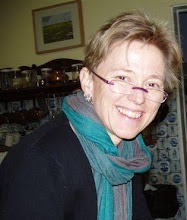We love color in our kitchen. Nothing beats vibrant red and yellow peppers on various shades of mixed green lettuces, done up in a sea-blue bowl with a sheen of olive oil to set it off. And did you know that the red peppers have twice as much vitamin C as the green ones, nine times the carotene plus the cancer-fighting phytochemical lycopene? True fact: I learned it from the American Institute for Cancer Research, home of all things healthy and cancer-preventive.
Experts often tout color as an indication of a healthy diet – the more color, the healthier the plate. Now Michael Pollan, our household’s hero du jour, has added his voice to the chorus. In his latest book, he suggests, “Eat your colors.”
I bought this book, Food Rules, on impulse, thinking I’d read it and then leave it out for the kids and their friends to pick up when they’re sitting around the living room, hanging out (sneaky way to turn them on to good health, I know). Formatted in micro chapters, it is an easily digestible, entertaining list of do’s and don’ts: what to eat, what to avoid, and a bit about why. I imagine it’s a condensed version of Pollan’s other books (In Defense of Food and The Omnivore’s Dilemma, which I have not yet read -- I am admittedly nonfiction-averse, someone who starts a non-fiction book with enthusiasm, gets distracted two chapters in and returns to the world of make believe. Food Rules is so short, though, I got through it just fine).
Food Rules includes such witticisms as “Don’t eat breakfast cereals that change the color of your milk” and “It’s not food if it arrived through the window of your car.” Some of my favorites include “Eat meals” (as opposed to endless stand-up snacking); “Don’t eat anything your great-grandmother wouldn’t recognize as food”; and “Eat mostly plants, especially leaves.” I also like, “Have a glass of wine with dinner.”
The kids haven’t had a chance to pick the book up in the living room – yet – but Clara wound up choosing it as the nonfiction assignment in English class. She read it with a friend, and now the two of them are experimenting with new habits – chewing your food until it’s liquid, for example, and crowding an omelet with veggies.
Not that I’m surprised -- many of the teens I’ve met care about what they eat and are various shades of vegetarian, have sensitivities to dairy or wheat, recognize the value of organic and would like to buy from local farmers (it helps that some of them have worked for the farmers at our nearby farmer’s market, selling produce on Sundays). Now that the Pollan book has made it into their consciousness, I am pleased not only for them, but for myself: They are reinforcing my belief in some of what he has to say. Clara even made her own rule, which she illustrated with fresh carrots and homemade pesto noodles on an orange colored plate: “Never eat food that is the same color as your plate, unless your plate is orange or green.” Makes for a beautiful meal.
Wednesday, April 7, 2010
Subscribe to:
Posts (Atom)
